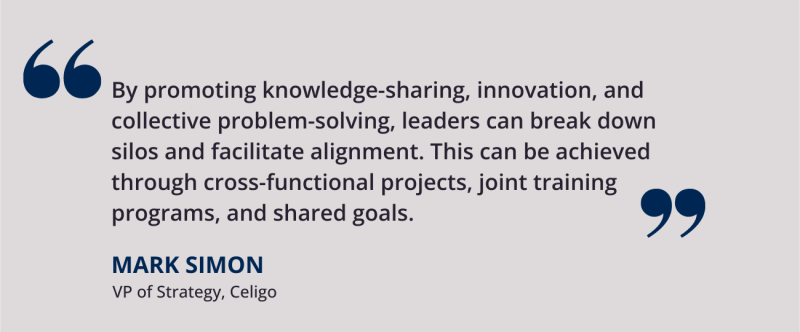Perfecting IT Integration to Achieve Faultless Functional Alignment
As retail and consumer goods companies embrace an increasing number of e-commerce point solutions at departmental and team levels, the complexity of integrating these solutions and data silos within the larger organization grows drastically.
These efforts require accurate, consistent, and up-to-date data across business systems such as e-commerce platforms, marketplaces, retail point-of-sale, ERP systems, warehouse management, customer data platforms, data warehouses, and more. This is only achievable through integration.
In this exclusive Q&A, Mark Simon, VP of strategy at Celigo, outlines how consumer goods companies and retailers can put seamless IT integrations in place while managing change and fostering greater collaboration and alignment in the process.
CGT: What are some of the largest and most common obstacles you see retail and consumer goods leaders face when it comes to ensuring successful IT integrations?
Mark Simon: The fast evolution of e-commerce technologies and business models compared to other industries, increases the need for more frequent replatforming projects, which make existing point-to-point integrations absolute. The tech debt from legacy in-house integrations has become hard to manage and maintain over time. With all of this, integration becomes complex, costly, and resource intensive.
CGT: How can they better ensure alignment between functions during such large-scale technology changes and disruption? Any tips for getting key stakeholders on board?
Simon: IT leaders should implement regular meetings, town halls, and other communication platforms to keep stakeholders informed about technological changes and their implications. They should also foster a culture of collaboration. By promoting knowledge-sharing, innovation, and collective problem-solving, leaders can break down silos and facilitate alignment. This can be achieved through cross-functional projects, joint training programs, and shared goals.
Next, they should involve stakeholders early and often: Leaders should seek feedback from various departments to understand their specific needs. This involvement increases alignment and commitment. By clearly articulating the benefits of the changes and developing a shared vision and goals, leaders can rally support and ensure alignment. Leaders should also ensure the necessary tools, infrastructure, and training are provided to all functions involved. By addressing resource gaps and equipping teams with the necessary skills, leaders can empower functions to adapt effectively.
CGT: What are some considerations when it comes to balancing standardization and customization with new systems across departments?
Simon: Decision-makers should understand departmental requirements: This involves conducting a comprehensive analysis of their specific needs, processes, and goals. Decision-makers can then identify areas where standardization or customization is necessary.
Once this is done, they should evaluate the impact on interoperability. Standardization promotes consistency and seamless integration, which can simplify data sharing and collaboration. However, customization might be required to ensure that systems can meet the needs of individual departments.
In the same vein, they should assess the scalability and flexibility requirements. Standardization can offer scalability benefits by enabling the adoption of uniform systems and processes.
Next up, it’s important to consider the impact on user experience. While standardization can provide a consistent user interface, customization can address specific user needs. It is essential to strike a balance between standardization and customization to ensure an optimal experience that maximizes efficiency and productivity.
Alongside this, decision-makers should evaluate the cost implications. Standardized solutions often offer cost savings through economies of scale, streamlined maintenance, and reduced training requirements. Customization can be more expensive due to development, integration, and ongoing maintenance costs. Decision-makers should carefully assess the cost-benefit trade-offs.
|
CGT: What are some of the key factors in developing secure, mutually beneficial relationships with outside partners who can help with integration change management? Simon: Trust and Reputation: When selecting outside partners, decision-makers should thoroughly evaluate their reputation, track record, and security practices. It's essential to work with partners who have a proven history of successful integration change management projects and a strong commitment to data security. Security and Compliance: Integration change management involves the sharing of sensitive data. Decision-makers should ensure that outside partners have robust security measures to protect data during transit, storage, and processing. Partners should comply with industry standards, and regulations (such as GDPR, HIPAA), and have data protection policies and procedures. Clear Roles and Responsibilities: This includes defining the scope of work, deliverables, and timelines. Clarity about the responsibilities of each party ensures accountability and minimizes the risk of misunderstandings. Communication and Collaboration: Decision-makers should foster open lines of communication and regular meetings with partners. Collaboration tools and platforms can facilitate real-time collaboration, document sharing, and issue tracking, enhancing the overall partnership experience. Shared Goals and Objectives: Decision makers should ensure that partners understand the organization's strategic objectives, business processes, and desired outcomes. Flexibility and Adaptability: A partner who can adjust their approach, provide innovative solutions, and proactively address issues can significantly contribute to a successful integration change management process. Knowledge Transfer and Training: This includes sharing organizational knowledge, processes, and best practices to enhance the partner's understanding of the organization's needs. Continuous Improvement and Support: Decision makers should seek partners who prioritize continuous improvement and offer ongoing support. This may include post-implementation reviews, monitoring and optimization of integrated systems, and proactive assistance in addressing any future challenges. |






